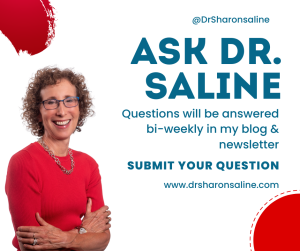Ask Dr. Saline: What Does ADHD Look in Black and Brown Girls?
 Dear Dr. Saline, Yesterday, I received a phone call from the school counselor about my daughter, age 12. She’s not completing her work in class, often forgets to turn in her homework, can’t recall directions, and spaces out during lessons. When she’s frustrated with an assignment, she loses her temper quickly. She’s been losing friends too. Based on some research, I’ve noticed these behaviors at home, and I think that she is showing “classic” symptoms of ADHD. But, at our last visit with Dr. Picone, he seemed to minimize my concerns about attention issues and talked about depression instead. He wanted to give her Prozac, but I refused. I think she is being underdiagnosed or misunderstood as a young Black girl, but I don’t know exactly what to do. Can you please explain how ADHD looks in Black and Brown girls and what I can do to figure this out? Thank you, Michelle. Sign-up for my newsletter + Free Handout | Ask Dr. Saline
Dear Dr. Saline, Yesterday, I received a phone call from the school counselor about my daughter, age 12. She’s not completing her work in class, often forgets to turn in her homework, can’t recall directions, and spaces out during lessons. When she’s frustrated with an assignment, she loses her temper quickly. She’s been losing friends too. Based on some research, I’ve noticed these behaviors at home, and I think that she is showing “classic” symptoms of ADHD. But, at our last visit with Dr. Picone, he seemed to minimize my concerns about attention issues and talked about depression instead. He wanted to give her Prozac, but I refused. I think she is being underdiagnosed or misunderstood as a young Black girl, but I don’t know exactly what to do. Can you please explain how ADHD looks in Black and Brown girls and what I can do to figure this out? Thank you, Michelle. Sign-up for my newsletter + Free Handout | Ask Dr. Saline
From Dr. Saline
Dear Michelle: I’m sorry to hear that you and your daughter are having such a frustrating experience. I’m glad that you waited to give her Prozac without more information. Unfortunately, many physicians, therapists and educators treat BIPOC children and teens differently than they do white kids. BIPOC boys and girls are less likely to be evaluated for ADHD even though they may show the same level of symptoms. Unfortunately, this is often due to implicit bias about Black and Brown people in the United States. We must acknowledge that structural racism affects outcomes. Practitioners have to take the time to investigate and receive training about the nature of our biases and how they could emerge in treatment. Sadly, Black and Brown people in America have been subjected to unfair treatment by health care and mental health practitioners over the years and have been coerced to be subjects in inhumane studies as well (e.g., the Tuskegee Syphilis Experiment). This makes it harder for them to trust a system to help when it’s caused so much harm in the past.
waited to give her Prozac without more information. Unfortunately, many physicians, therapists and educators treat BIPOC children and teens differently than they do white kids. BIPOC boys and girls are less likely to be evaluated for ADHD even though they may show the same level of symptoms. Unfortunately, this is often due to implicit bias about Black and Brown people in the United States. We must acknowledge that structural racism affects outcomes. Practitioners have to take the time to investigate and receive training about the nature of our biases and how they could emerge in treatment. Sadly, Black and Brown people in America have been subjected to unfair treatment by health care and mental health practitioners over the years and have been coerced to be subjects in inhumane studies as well (e.g., the Tuskegee Syphilis Experiment). This makes it harder for them to trust a system to help when it’s caused so much harm in the past.
Misdiagnosing ADHD Symptoms
 So many girls are referred for counseling for anxiety or depression without considering other factors such as attention or learning challenges. This is especially true for Black and Brown girls. They may hide what’s really happening to avoid getting in trouble, being considered stupid, or getting teased. Misdiagnosing or overlooking ADHD symptoms means that your daughter, like other kids with ADHD, is more likely to engage in risky behaviors and substance use and demonstrate serious mood disorders later in life. This is especially true for ADHD in Black and Brown girls. They often come across as older than they actually are. This complicates things for kids with ADHD, who can be up to three years less mature than their peers. Plus, many BIPOC parents think that ADHD is another unwanted label. It may be possible that their students deny their struggles in an effort to comply with this cultural belief.
So many girls are referred for counseling for anxiety or depression without considering other factors such as attention or learning challenges. This is especially true for Black and Brown girls. They may hide what’s really happening to avoid getting in trouble, being considered stupid, or getting teased. Misdiagnosing or overlooking ADHD symptoms means that your daughter, like other kids with ADHD, is more likely to engage in risky behaviors and substance use and demonstrate serious mood disorders later in life. This is especially true for ADHD in Black and Brown girls. They often come across as older than they actually are. This complicates things for kids with ADHD, who can be up to three years less mature than their peers. Plus, many BIPOC parents think that ADHD is another unwanted label. It may be possible that their students deny their struggles in an effort to comply with this cultural belief.
Client Experience
Recently, the father of one of my clients, a ten-year-old African-American male who was just diagnosed with ADHD and dyslexia, said to me: “Dr. Sharon, I don’t want him to have another label. It’s hard enough growing up Black today. This could just be something else that holds him back.” This is a very valid concern, and I really empathize. However, research shows that kids of all ethnicity with ADHD do better with useful interventions at school combined with family therapy to develop effective strategies at home and, lastly, medication. While pills don’t teach skills and the decision to take medication is personal, it is worth noting that the combination treatment produces the best results. Many families, especially those with limited access to health care, can be misinformed about the effects and benefits of medication. Do some research on well-respected sites such as ADDitudemag.com, Chadd.org, add.org, WebMD.com, Healthline.com, or Understood.com.
“While pills don’t teach skills and the decision to take medication is a personal one, it is worth noting that the combination treatment produces the best results.” ~ Dr. Sharon Saline, Clinical Psychologist
Getting An Accurate Diagnosis
 Let’s look beyond your daughter’s symptoms to what else might happen. Almost 64% of kids with ADHD have a co-occurring second diagnosis, often a learning disability, anxiety, or something else. Unfortunately, many educators and providers over-focus on the secondary diagnosis or make character judgments without investigating further, especially for BIPOC kids. Too many adults zoom in on objectionable behaviors without sufficiently considering racial, socioeconomic, and psychological stressors. That’s why getting a valid diagnosis is critical.
Let’s look beyond your daughter’s symptoms to what else might happen. Almost 64% of kids with ADHD have a co-occurring second diagnosis, often a learning disability, anxiety, or something else. Unfortunately, many educators and providers over-focus on the secondary diagnosis or make character judgments without investigating further, especially for BIPOC kids. Too many adults zoom in on objectionable behaviors without sufficiently considering racial, socioeconomic, and psychological stressors. That’s why getting a valid diagnosis is critical.
Two Ways to Get An Evaluation:
1) Go to the principal or guidance counselor at her school and ask how you initiate a special education evaluation, or go directly to the pupil services office for your school district and initiate the process. 2) Check with your insurance company and your doctor’s office for referrals of people who perform assessments. In my last Ask Dr. Sharon blog, I detailed what to look for in this evaluation, but it should include tests of intellectual capabilities, visual and spatial processing skills, and rating forms that target anxiety, trauma, depression, and executive functioning skills. It’s important for the evaluator to understand that life stressors may worsen executive functioning skills. Remember, schools can’t diagnose ADHD because it is a health condition, but they can say that results point in that direction.
Research
Recently, a new study from the CDC found an alarming increase in sadness and exposure to violence among teen girls. This is particularly alarming for neurodivergent girls, particularly those of color, who are frequently misperceived by adults as older than they are, may be unfairly targeted as being aggressive, and may already lack self-esteem or confidence. When you add into the mix that inattentive girls are often diagnosed later in life because so many adults miss the signs or ignore them, the risk of missing ADHD in BIPOC girls increases. Instead, there are multiple referrals for anxiety, depression or oppositional behaviors. Then these girls can be excluded from their peers because of missing social cues or spacing out during the conversation at lunch.
particularly alarming for neurodivergent girls, particularly those of color, who are frequently misperceived by adults as older than they are, may be unfairly targeted as being aggressive, and may already lack self-esteem or confidence. When you add into the mix that inattentive girls are often diagnosed later in life because so many adults miss the signs or ignore them, the risk of missing ADHD in BIPOC girls increases. Instead, there are multiple referrals for anxiety, depression or oppositional behaviors. Then these girls can be excluded from their peers because of missing social cues or spacing out during the conversation at lunch.
In Conclusion
If your daughter receives a diagnosis of ADHD, help her take ownership of it. As a family, seek out research, so all of you fully understand what it means to wrestle with attention issues as a person of color. Learning about how her brain works are critical to accepting her challenges and advocating for her needs. It’s very important for Black and Brown kids to be able to identify what is helpful, what is working, and what they need so they feel empowered as learners and as neurodivergent adults. This will set the stage for self-advocacy throughout their lives. With a thorough evaluation, thoughtful interventions at school and home, and possibly medication, your daughter can thrive and develop into the productive, successful, and confident adult you want her to become. Thank you for your question! Be sure to join my upcoming webinars to learn more.
Want to ask Dr. Saline a question? Click Here
Become A Member
Please become a member of my newsletter community. You can find support and resources and connect with a group that understands your questions and needs. Click here Follow me on social media: YouTube, Facebook, Twitter, and Instagram. Invite Me to Speak | Join A Group | Newsletter | Read my blog
Sign-up for my newsletter today and receive 10% off!

